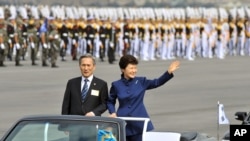SEOUL —
South Korea held a massive military parade on Tuesday; mainly to celebrate the 65th anniversary of the founding of its armed forces, but also to deter provocations from North Korea. The show of strength comes as top U.S. defense officials visit the South Korean capital, Seoul, for talks on security and the military defense of South Korea.
During the parade, South Korea publicly displayed for the first time locally-developed cruise missiles capable of precision strikes in North Korea: the Hyunmu-2, with a range of 500 kilometers, and the Hyunmu-3, with a range of 1,000 kilometers.
The parade ran through the South Korean capital for several hours and included thousands of soldiers, military vehicles and tanks.
In a live broadcast, jets performed aerial acrobatics for the audience of dignitaries and commanders at Seoul Air Base in Seongnam, just south of the capital.
Visitors included U.S. Secretary of Defense Chuck Hagel and General Martin Dempsey, the chairman of the Joint Chiefs of Staff.
South Korea's Defense Ministry said the display of military might was the largest in a decade.
South Korean President Park Geun-hye made clear the show was also meant for those watching in Pyongyang. Speaking at the opening ceremony, she vowed to strengthen defense capabilities to warn off threats from North Korea.
Park says South Korea must establish a strong deterrent against North Korea until it gives up its nuclear programs and makes the right choices for its people and peace on the Korean peninsula.
In February, North Korea defied the international community by testing its third nuclear device. Pyongyang also threatened preemptive strikes against Seoul and Washington.
Tensions later cooled, but recent satellite photos indicate North Korea has expanded its uranium facilities, restarted a plutonium reactor, and began testing a long-range rocket engine.
Pyongyang claims its rockets are for peaceful satellite launches, but they are widely believed to be cover for developing intercontinental ballistic missiles.
President Park described the security situation on the Korean Peninsula as “very grave,” but said the value of the military lies not in making war but in preventing it.
She said South Korea will make North Korea realize that the nuclear power and missiles it clings to are useless. They will do so, she says, by maintaining the South Korea - U.S. joint defense system and developing response capabilities, such as the Korea Air and Missile Defense System (KAMD) against Weapons of Mass Destruction (WMD).
President Park and the visiting U.S. defense officials marked the 60th anniversary of their military alliance this week. The two sides' military officials also discussed cooperation, capabilities and the threat from North Korea.
The United States led U.N. troops in 1950 to repel a North Korean invasion that sparked the Korean War.
The fighting ended in an armistice but, to prevent further aggression, 28,000 U.S. troops still remain in South Korea and Washington holds war-time control over its 600,000 soldiers.
Washington says South Korea's capabilities have advanced enough to take back that responsibility, but Seoul wants the 2015 transfer deadline to be extended for a second time due to the continuing threat from North Korea.
VOA Seoul Bureau producer Youmi Kim contributed to this report.
During the parade, South Korea publicly displayed for the first time locally-developed cruise missiles capable of precision strikes in North Korea: the Hyunmu-2, with a range of 500 kilometers, and the Hyunmu-3, with a range of 1,000 kilometers.
The parade ran through the South Korean capital for several hours and included thousands of soldiers, military vehicles and tanks.
In a live broadcast, jets performed aerial acrobatics for the audience of dignitaries and commanders at Seoul Air Base in Seongnam, just south of the capital.
Visitors included U.S. Secretary of Defense Chuck Hagel and General Martin Dempsey, the chairman of the Joint Chiefs of Staff.
South Korea's Defense Ministry said the display of military might was the largest in a decade.
South Korean President Park Geun-hye made clear the show was also meant for those watching in Pyongyang. Speaking at the opening ceremony, she vowed to strengthen defense capabilities to warn off threats from North Korea.
Park says South Korea must establish a strong deterrent against North Korea until it gives up its nuclear programs and makes the right choices for its people and peace on the Korean peninsula.
In February, North Korea defied the international community by testing its third nuclear device. Pyongyang also threatened preemptive strikes against Seoul and Washington.
Tensions later cooled, but recent satellite photos indicate North Korea has expanded its uranium facilities, restarted a plutonium reactor, and began testing a long-range rocket engine.
Pyongyang claims its rockets are for peaceful satellite launches, but they are widely believed to be cover for developing intercontinental ballistic missiles.
President Park described the security situation on the Korean Peninsula as “very grave,” but said the value of the military lies not in making war but in preventing it.
She said South Korea will make North Korea realize that the nuclear power and missiles it clings to are useless. They will do so, she says, by maintaining the South Korea - U.S. joint defense system and developing response capabilities, such as the Korea Air and Missile Defense System (KAMD) against Weapons of Mass Destruction (WMD).
President Park and the visiting U.S. defense officials marked the 60th anniversary of their military alliance this week. The two sides' military officials also discussed cooperation, capabilities and the threat from North Korea.
The United States led U.N. troops in 1950 to repel a North Korean invasion that sparked the Korean War.
The fighting ended in an armistice but, to prevent further aggression, 28,000 U.S. troops still remain in South Korea and Washington holds war-time control over its 600,000 soldiers.
Washington says South Korea's capabilities have advanced enough to take back that responsibility, but Seoul wants the 2015 transfer deadline to be extended for a second time due to the continuing threat from North Korea.
VOA Seoul Bureau producer Youmi Kim contributed to this report.








